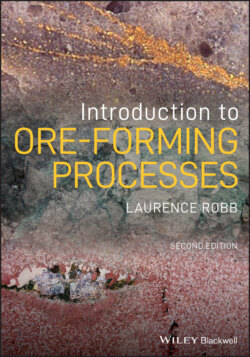Читать книгу Introduction to Ore-Forming Processes - Laurence Robb - Страница 14
What Makes a Viable Mineral Deposit?
ОглавлениеOre deposits form when a useful commodity is sufficiently concentrated in an accessible part of the Earth's crust so that it can be profitably extracted. The processes by which this concentration occurs are the topic of this book. As an introduction it is pertinent to consider the range of concentration factors that characterize the formation of different ore deposit types. Some of the strategically important metals, such as Fe, Al, Mg, Ti, and Mn, are abundantly distributed in the Earth's crust (i.e. between about 0.5% and 10%) and only require a relatively small degree of enrichment in order to make a viable deposit. Table 1 shows that Fe and Al, for example, need to be concentrated by factors of 9 and 4 respectively, relative to average crustal abundances, in order to form potentially viable deposits.
Table 1 Average crustal abundances for selected metals and typical concentration factors that need to be achieved in order to produce a viable ore deposit.
Source: Average crustal abundances from Rudnick and Gao (2014). Reproduced with permission of Elsevier.
| Average crustal abundance | Typical exploitable grade | Approximate concentration factor | |
| Al | 8.4% | 30% | ×4 |
| Fe | 5.2% | 50% | ×9 |
| Cu | 27 ppm | 1% | ×370 |
| Ni | 59 ppm | 1% | ×170 |
| Zn | 72 ppm | 5% | ×700 |
| Sn | 1.7 ppm | 0.5% | ×2900 |
| Au | 1.3 ppb | 2 g t−1 | ×1500 |
| Pt | 1.5 ppb | 5 g t−1 | ×3300 |
Note: 1 ppm is the same as 1 g t−1.
By contrast, base metals such as Cu, Zn, and Ni are much more sparsely distributed and average crustal abundances are only in the range 30–70 parts per million (ppm). The economics of mining dictate that these metals need to be concentrated by factors in the hundreds in order to form potentially viable deposits – degrees of enrichment that are an order of magnitude higher than those applicable to the more abundant metals. The degree of concentration required for the precious metals is even more demanding, where the required enrichment factors are in the thousands. Table 1 shows that average crustal abundances for Au and Pt are in the range 1–2 parts per billion (ppb) and even though mines routinely extract these metals at grades of around 1–5 g t−1, the enrichment factors involved are between 1000 and 3000 times.
Another useful way to distinguish between the geochemically abundant and scarce metals is to plot average crustal abundances against production estimates. This type of analysis was first carried out by Skinner (1976), who used a plot like that in Figure 2 to confirm that crustal abundance is a reasonable measure of the availability of a given resource. It is by design and of necessity that we use more of the geochemically abundant metals than we do the scarce ones. The nature of our technologies and the materials we use to manufacture mechanical items depend in large measure on the availability of raw materials. As an example, the technologies (geological and metallurgical) that resulted in a dramatic increase in global aluminum production over the latter part of the twentieth century, allowed iron to be replaced by aluminum in many products such as motor vehicles. More importantly, though, Figure 2 allows estimates to be made of the relative rates of depletion of certain metals relative to others. These trends are discussed again below.
Figure 2 Plot of global production against crustal abundances for a number of metal commodities. The line through Fe can be regarded as a datum against which the rates of production of the other metals can be compared in the context of crustal abundances.
Source: After Einaudi (2000).
